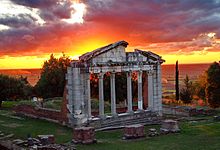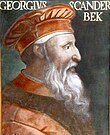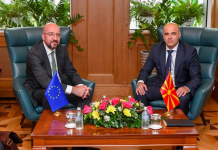Васе Хефталица е непоправлив албанофоб, тој сега стана поголем албанофоб дури и од оној грев Тале од Прилеп. Васето нашол некое сирото деденце по име Каплан Буровиќ кој живеел некаде помеѓу границата на Црна Гора и Албанија и кој бил во албански затвор во Албанија поради неговите штетни теории за потеклото на албанците и кое цел живот го поминало да докаже дека албанците се всушност некои наследници на Илирите кои живееле на овие простори од античкото време.
Значи Ефтов сега прави каша попара со поновата македонска историја и ја турка опасната теза за тоа дека сите етнички националности на оваа територија се дојденци што значи по дифолт дека сите тие треба да се протераат или исчистат од Македонија?! Ова се тие опасни тези и емисии кои куртонот Ефтов ги прави а за кои дел од големите компании го финансираат, значи ем плаши раја со терористи, ем прави луди анти муслимански и анти албански теории со кои прави раздор во мултиетничкото ткиво на државата и ем турка опасни тези за етнички чистења!
Но современата светска наука е сосема јасна и сигурна дека Албанците се наследници на Илирите, кои живееле на овие простори од античко време. Ако некој се доселил на овие простори, тоа сме ние, Словените.
VIDEO
The term Albania is the medieval Latin name of the country. It may be derived from the Illyrian tribe of Albani (Albanian: Albanët ) recorded by Ptolemy, the geographer and astronomer from Alexandria, who drafted a map in 150 AD, which shows the city of Albanopolis located northeast of the city of Durrës.[17] [18] The term may have a continuation in the name of a medieval settlement called Albanon or Arbanon, although it is not certain that this was the same place.[19] In his history written in the 10th century, the Byzantine historian Michael Attaliates was the first to refer to Albanoi as having taken part in a revolt against Constantinople in 1043 and to the Arbanitai as subjects of the Duke of Dyrrachium.[20] During the Middle Ages, the Albanians called their country Arbëri or Arbëni and referred to themselves as Arbëreshë or Arbëneshë .[21] [22]
Nowaday, Albanians call their country Shqipëri or Shqipëria . As early as the 17th century the placename Shqipëria and the ethnic demonym Shqiptarë gradually replaced Arbëria and Arbëresh . The two terms are popularlyinterpreted as “Land of the Eagles” and “Children of the Eagles”.[23] [24]
The first traces of human presence in Albania, dating to the Middle Paleolithic and Upper Paleolithic eras, were found in the village of Xarrë close to Sarandë and Dajti near Tiranë.[25] The objects found in a cave near Xarrë include flint and jasper objects and fossilized animal bones, while those found at Mount Dajt comprise bone and stone tools similar to those of the Aurignacian culture. The Paleolithic finds of Albania show great similarities with objects of the same era found at Crvena Stijena in Montenegro and north-western Greece.[25]
Several Bronze Age artefacts from tumulus burials have been unearthed in central and southern Albania that show close connection with sites in south-western Macedonia and Lefkada, Greece. Archaeologists have come to the conclusion that these regions were inhabited from the middle of the third millennium BC by Indo-European people who spoke a Proto-Greek language. A part of this population later moved to Mycenae around 1600 BC and founded the Mycenaean civilisation there.[26] [27] [28] Another population group, the Illirii, probably the southernmost Illyrian tribe of that time[29] that lived on the border of Albania and Montenegro, possibly neighbored the Greek tribes.[29] [30]
In ancient times, the territory of modern Albania was mainly inhabited by a number of Illyrian tribes. This territory was known as Illyria, corresponding roughly to the area east of the Adriatic sea to the mouth of the Vjosë river in the south.[31] [32] The first account of the Illyrian groups comes from Periplus of the Euxine Sea , an ancient Greek text written in the middle of the 4th century BC.[33] The south was inhabited by the Greek tribe of the Chaonians,[34] whose capital was at Phoenice, while numerous colonies, such as Apollonia, Epidamnos and Amantia, were established by Greek city-states on the coast by the 7th century BC.[35]
One of the most powerful tribes that ruled over modern Albania was the Ardiaei. The Ardiaean Kingdom reached its greatest extent under Agron, son of Pleuratus II. Agron extended his rule over other neighboring tribes as well.[36] After Agron’s death in 230 BC, his wife Teuta inherited the Ardiaean kingdom. Teuta’s forces extended their operations further southward into the Ionian Sea.[37] In 229 BC, Rome declared war[38] on Illyria for extensively plundering Roman ships. The war ended in Illyrian defeat in 227 BC. Teuta was eventually succeeded by Gentius in 181 BC.[39] Gentius clashed with the Romans in 168 BC, initiating the Third Illyrian War. The conflict resulted in Roman conquest of the region by 167 BC. After that the Roman split the region into three administrative divisions.[40]
When the Roman Empire divided into east and west in the 4th century, Albania remained under the Byzantine control until the late 7th century, when Bulgarians began to overrun parts of the country.[41] During that period, the Balkans including Albania, suffered from the dislocation of the Barbarian Invasions. After the weakening of the Byzantine and the Bulgarian Empire in the 13th century, parts of the country has been captured by the Venetian and Serbian Empire. In general, the invaders destroyed or weakened Roman and Byzantine cultural centers in Albania.[42]
The history of medieval Albania as a unified state began in 1190, when archon Progon of Kruja established the Principality of Arbanon with the capital in Krujë. Progon, was succeeded by his sons Gjin and Dhimitri, the latter which attained the height of the realm. Following the death of Dhimiter, the last member of the Progon family, the principality came under the Albanian-Greek Gregory Kamonas and later Golem of Kruja.[43] [44] [45] Anyways in the 13th century, the principality was dissolved.[46] [47] [48] Arbanon is considered to be the first sketch of an Albanian state, that retained a semi-autonomous status as the western extremity of an empire, under the Byzantine Doukai of Epirusor Laskarids of Nicaea.[49]
Few years after the dissolution of Arbanon, Charles of Anjou concluded an agreement with the Albanian rulers, promising to protect them and their ancient liberties. In 1272, he established the Kingdom of Albania and conquered regions back from the Despotate of Epirus. The kingdom claimed all of central Albania territory from Dyrrhachium along the Adriatic Sea Coast down to Butrint. A catholic political structure was a basis for the papal plans of spreading Catholicism in the Balkan Peninsula. This plan found also the support of Helen of Anjou, a cousin of Charles of Anjou, who was at that time ruling territories in North Albania. Around 30 Catholic churches and monasteries were built during her rule mainly in Northern Albania.[50] From 1331 to 1355, the Serbian Empire wrestled control over Albania. In 1367, various Albanian rulers established the Despotate of Arta. During that time, several Albanian principalities were created, most notable amongst them the Balsha, Thopia, Kastrioti, Muzaka and Arianiti. In the first half of the 14th century, the Ottoman Empire invaded most of Albania and the League of Lezhë was held under Skanderbeg as a ruler, who became the national hero of the Albanian medieval history.
At the dawn of the establishment of the Ottoman Empire in southeastern Europe, the geopolitical landscape was marked by scattered kingdoms of small principalities. The Ottomans erected their garrisons throughout southern Albania in 1415 and occupied most of the country in 1431.[51] However, in 1443 a great and longstanding revolt broke out under the lead of the Albanian national hero George Castrioti Skanderbeg (Gjergj Kastrioti Skënderbeu) , which lasted until 1479, many times defeating major Ottoman armies led by the sultans Murad II and Mehmed II. Skanderbeg united initially the Albanian princes, and later on established a centralized authority over most of the non-conquered territories, becoming the ruling Lord of Albania . He also tried relentlessly but rather unsuccessfully to create a European coalition against the Ottomans. He thwarted every attempt by the Turks to regain Albania, which they envisioned as a springboard for the invasion of Italy and western Europe. His unequal fight against the mightiest power of the time, won the esteem of Europe as well as some support in the form of money and military aid from Naples, Venice, Ragusa and the Papacy.[52] With the arrival of the Ottomans, Islam was introduced in the country as a third religion. This conversion caused a massive emigration of Albanians to other Christian European countries, especially the Arbëreshë of Italy.[53] As Muslims, some Albanians attained important political and military positions within the Ottoman Empire and culturally contributed to the wider Muslim world.[54]
Enjoying this privileged position in the empire, Muslim Albanians held various high administrative positions, with over two dozen Grand Viziers of Albanian origin, such as Gen. Köprülü Mehmed Pasha, who commanded the Ottoman forces during the Ottoman-Persian Wars; Gen. Köprülü Fazıl Ahmed, who led the Ottoman armies during the Austro-Turkish War; and later Muhammad Ali Pasha of Egypt.[55]
During the 15th century, when the Ottomans were gaining a firm foothold in the region, Albanian towns were organised into four principal sanjaks. The government fostered trade by settling a sizeable Jewish colony of refugees fleeing persecution in Spain (at the end of the 15th century). The city of Vlorë saw passing through its ports imported merchandise from Europe such as velvets, cotton goods, mohairs, carpets, spices, and leather from Bursa and Constantinople. Some citizens of Vlorëeven had business associates throughout Europe.[55]
Albanians could also be found throughout the empire in Iraq, Egypt, Algeria and across the Maghreb, as vital military and administrative retainers.[56] This was partly due to the Devşirme system. The process of Islamization was an incremental one, commencing from the arrival of the Ottomans in the 14th century (to this day, a minority of Albanians are Catholic or Orthodox Christians, though the majority became Muslim). Timar holders, the bedrock of early Ottoman control in southeast Europe, were not necessarily converts to Islam, and occasionally rebelled; the most famous of these rebels is Skanderbeg (his figure would rise up later on, in the 19th century, as a central component of the Albanian national identity). The most significant impact on the Albanians was the gradual Islamisation process of a large majority of the population, although it became widespread only in the 17th century.[54]
Mainly Catholics converted in the 17th century, while the Orthodox Albanians followed suit mainly in the following century. Initially confined to the main city centres of Elbasan and Shkodër, by this period the countryside was also embracing the new religion. The motives for conversion according to some scholars were diverse, depending on the context. The lack of source material does not help when investigating such issues.[54] Albania remained under Ottoman control as part of the Rumelia province until 1912, when independent Albania was declared.
Што се однесува до Дарданите, еве ја нивната приказна:
The Dardani are first mentioned in the 4th century BC, when their king Bardylis succeeded in bringing various tribes into a single organization. Under his leadership the Dardani defeated the Macedonians and Molossians several times. At this time they were strong enough to rule Macedonia through a puppet king in 392-391 BC. In 385-384 they allied with Dionysius I of Syracuse and defeated the Molossians, killing up to 15,000 of their soldiers and ruling their territory for a short period. Their continuous invasions forced Amyntas III of Macedon to pay them a tribute in 372 BC. They returned raiding the Molossians in 360. In 359 BC Bardylis won a decisive battle against Macedonian king Perdiccas III, whom he killed himself, while 4,000 Macedonian soldiers fell, and the cities of upper Macedonia were occupied.[14] [15] Following this disastrous defeat, king Philip II took control of the Macedonian throne in 358 and reaffirmed the treaty with the Dardani, marrying princess Audata, probably the daughter or niece of Bardylis. The time of this marriage is somewhat disputed while some historians maintain that the marriage happened after the defeat of Bardylis.[16] This gave Philip II valuable time to gather his forces against those Dardani who were still under Bardylis, defeating them at the Erigon Valley by killing about 7,000 of them, eliminating the Dardani menace for some time.[15] [17]
In 334 BC, under the leadership of Cleitus, the son of Bardylis, the Dardani, in alliance with other Illyrian tribes attacked Macedonia held by Alexander the Great. The Dardani managed to capture some cities but were eventually defeated by Alexander’s forces.[14]
Celts were present in Dardania in 279 BC. The Dardanian king offered to help the Macedonians with 20,000 soldiers against the Celts, but this was refused by Macedonian king Ptolemy Keraunos.[19] [20]
Dardani were a constant threat to the Macedonian kingdom. In 230 under Longarus[21] they captured Bylazora from the Paionians[22] and in 229 they again attacked Macedonia, defeating Demetrius II in an important battle.[23] In this period their influence on the region grew and some other Illyrian tribes defected Teuta joining the Dardani under Longarus, forcing Teuta to call off her expedition forces in Epirus.[24] When Philip V rose to the Macedonian throne, skirmishing with Dardani began in 220-219 BC and he managed to capture Bylazora from them in 217 BC. Skirmishes continued in 211 and in 209 when a force of Dardani under Aeropus, probably a pretender to the Macedonian throne, captured Lychnidus and looted Macedonia taking 20.000 prisoners and retreating before Philip’s forces could reach them.[25]
In 201 Bato of Dardania along with Pleuratus the Illyrian and Amynander king of Athamania, cooperated with Roman consul Sulpicius in his expedition against Philip V.[26] Being always under the menace of Dardanian attacks on Macedonia, around 183 BC Philip V made an alliance with the Bastarnae and invited them to settle in Polog, the region of Dardania closest to Macedonia.[27] A joint campaign of the Bastarnae and Macedonians against the Dardanians was organized, but Philip V died and his son Perseus of Macedon withdrew his forces from the campaign. The Bastarnae crossed the Danube in huge numbers and although they didn’t meet the Macedonians, they continued the campaign. Some 30,000 Bastarnae under the command of Clondicus seem to have defeated the Dardani.[28] In 179 BC, the Bastarnae conquered the Dardani, who later in 174 pushed them out, in a war which proved catastrophic, with a few years later, in 170 BC, the Macedonians defeating the Dardani. Macedonia and Illyria became Roman protectorates in 168 BC. The Scordisci, a tribe of Celtic origin, most likely subdued the Dardani in the mid-2nd century BC, after which there are for long no mention of the Dardani.
Macedonia and Illyria became Roman protectorates in 168 BC.
In 97 BC the Dardani are mentioned again, defeated by the Macedonian Roman army. In 88 BC, the Dardani invaded the Roman province of Macedonia together with the Scordisci and the Maedi.[33] [not in citation given ]
According to Strabo’s Geographica (compiled 20 BC–23 AD), they were divided into two sub-groups, the Galabri and the Thunaki.[34]
It seems quite probable that the Dardani actually lost independence in 28 BC thus, the final occupation of Dardania by Rome has been connected with the beginnings of Augustus’ rule in 6 AD, when they were finally conquered by Rome. Dardania was conquered by Gaius Scribonius Curio and the Latin language was soon adopted as the main language of the tribe as many other conquered and Romanized.[35]
At first, Dardania was not a separate Roman province, but became a region in the province of Moesia Superior in 87 AD.[36] Emperor Diocletian later (284) made Dardania into a separate[36] province with its capital at Naissus (Niš). During the Byzantine administration (in the 6th century), there was a Byzantine province of Dardania that included cities of Ulpiana, Scupi, Stobi, Justiniana Prima, and others.
The Illyrian language disappeared, with almost nothing of it surviving, except for names.[37] The Illyrian tribes in antiquity were subject to varying degrees of Celticization,[38] [39] Hellenization,[40] Romanization[41] [42] Byzantinization, and finally Slavicisation.
It is assumed that the Dardanian kingdom was made up of many tribes and tribal groups, confirmed by Strabo.[43] The first and most prominent king of the Dardani was Bardylis[44] who ruled from 385 BC to 358 BC.[citation needed ] Bardylis’ descendance (and inheritance) is unclear; Hammond believed that Bardylis II was the son of Bardylis,[45] earlier having believed it to have been Cleitus (as per Arrian),[46] while Wilkes believed Cleitus to be the son.[47] Tribal chiefs Longarus and his son Bato took part in the wars[3] against Romans and Macedonians. The Dardanians, in all their history, always had separate domains from the rest of the Illyrians.[48]
The term used for their territory was (Δαρδανική),[49] while other tribal areas had more unspecified terms, such as Autariaton khora (Αὐταριατῶν χώρα), for the “land of Autariatae.” Other than that, little to no data[50] exists on the territory of the Dardani prior to Roman conquest, especially on its southern extent.
According to Ancient Greek and Roman historiography, the tribe was viewed of as “extremely barbaric”.[51] [page needed ] [52] Claudius Aelianus and other writers[who? ] wrote that they bathed only three[53] times in their lives. At birth, when they were wed and after they died. Strabo refers to them as wild[54] and dwelling in dirty caves under dung-hills.[55] This however may have had to do not with cleanliness, as bathing had to do with monetary[52] status from the viewpoint of the Greeks. At the same time, Strabo writes that they had some interest in music as they owned and used flutes and corded instruments.[55]
Dardanian slaves or freedmen at the time of the Roman conquest were clearly of Paleo-Balkan origin, according to their personal names. It has been noted that personal names were mostly of the “Central-Dalmatian type”.
An extenstive study based on onomastics has been undertaken by Radoslav Katičić which puts the Dardani language area in the Central Illyrian area (“Central Illyrian” consisting of most of former Yugoslavia, north of southern Montenegro to the west of Morava, excepting ancient Liburnia in the northwest, but perhaps extending into Pannonia in the north).[58] [59]











.gif)
.gif)














